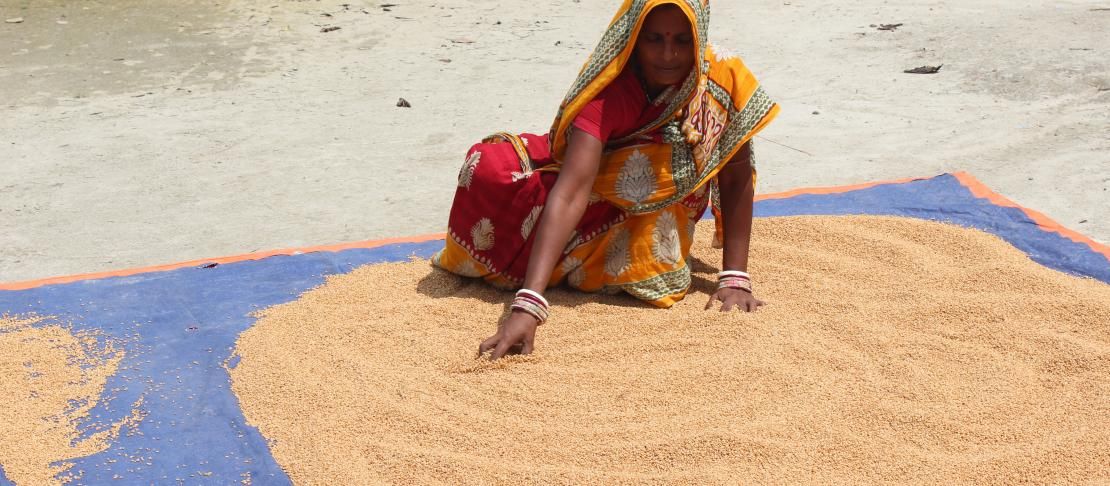Empowering women farmers to combat climatic risks while enhancing livelihoods and household nutrition

At a recent workshop, women farmers from Bihar, India were trained on the benefits of climate-smart farm practices, including value addition for their products.
Risk management in agriculture has become more complex due to the added pressures of climate change. In high-risk prone areas like the Indo-Gangetic belt of India, farmers have time and again resorted to formal and informal ways of mitigating risks in farming. Crop diversification has been one such mechanism. It not only allows farmers to increase their capacity for dealing with climatic uncertainties but also helps them pursue alternative means of income generation and household nutrition improvement. This adds to overall resilience, especially for marginalized groups like women farmers.
A workshop for capacity enhancement of women farmers on climate-smart agriculture for dealing with climatic risks was held in Bihar, India, on 26–27 June. It was jointly organized by the International Maize and Wheat Improvement Center (CIMMYT), Dr. Rajendra Prasad Central Agricultural University (DRPCAU), Indian Council of Agricultural Research, Borlaug Institute for South Asia under the aegis of the CGIAR Research Program on Climate Change, Agriculture and Food Security (CCAFS). Titled, "Crop diversification and value addition workshop for women of Bihar," the training workshop was designed to disseminate knowledge to women farmers from both Climate-Smart Villages (CSVs) and non-CSVs regarding crop diversification as a means for imrpoving resilience to climatic risks, as well as to train them on value addition for products for income strengthening.
Disseminating knowledge helps to inform choices
The workshop was designed to achieve multiple objectives, including:
- Educating women farmers on the benefits of crop diversification while sharing the results from CSVs;
- Enhancing the knowledge base of women farmers about climate-smart agricultural practices (CSAPs) and their use for increasing yield and income;
- Building resilience to climatic risks by encouraging adoption of practices like crop diversification, and harnessing the nutritional potential of crops like maize and legumes for improved household nutrition during times of risks; and
- Disseminating skill-based training on value addition through food preservation techniques, for higher income.
Twenty-three women farmers from both CSV (9) and non-CSV (14) sites attended the workshop and were joined by members from academia and development partners. Beneficiaries from both types of sites were included to capture insights from both groups, map the gains made with CCAFS interventions and assess the scope for expansion in non-CSV areas. Both CSV and non-CSV participants cited increased adoption of crop diversification in their villages. However, due to the continued use of conventional tillage and local seed varieties in the non-CSV sites, there has been minimal impact on yields. In contrast, participants from the CSV site could demonstrate higher yields on their farms due to practices like bed planting and use of hybrid seed varieties.
Non-CSV participants highlighted the modest adoption of climate-smart techniques such as zero tillage and improved seed varieties on their farms. Conversely, due to the robust adoption of CSAPs in the CSV, the CSV participants reported an approximately 100% increase in the yield of certain crops like maize. Since the beginning of the CSV project in 2013, farmers have been trained on the combined application of a portfolio of locally contextualized CSAPs, including nutrient management practices. CSV participants shared their experiences in the use of tools such as the nutrient expert tool and the green seeker. They also attested to the availability of regular ICT-based agro-advisory services to help them make informed choices. Of the non-CSV participants, 36% reported having access to such agro-advisories. Armed by the validation received from their CSV neighbours and the information received on the benefits of CSAPs for risk mitigation as well as nutrition improvement within the household, non-CSV participants expressed interest in scaling adoption of CSAPs on their own farms.
Training for empowerment
The workshop also provided training on value addition for farm products. To encourage diversity in production, apart from rice, wheat and maize, legumes and soybean were promoted. Seasoned trainers brought in from the Department of Foods & Nutrition, College of Community Science of DRPCAU, provided hands-on training on food preservation and processing techniques for cereals, pulses and vegetables. This former included better grain storage techniques, including theory on temperature and moisture content for wheat, rice and maize. Participants also learned about the benefits of having lime-treated dehydrated sprouted grains, which have better shelf life as well as improved nutrient intake.
Furthermore, knowledge on seed germination and treatment for wheat, maize, ragi and moong (mung) bean was provided. Other supplements like sesame seeds, peanuts, and flax seeds were also introduced as good sources of energy and Omega 3 fatty acids for brain development. Participants became acquainted with the income generating capacities of these crops, which, after processing, can be used and marketed as baby food, and health supplements for adults and lactating mothers, etc. With the right business models, encouragement to create self-help groups, and market linkages, this kind of knowledge can lead to profit-making ventures for women farmers, supporting their livelihood enhancement and social empowerment.
Tripti Agarwal is a Project Administrator at CIMMYT South Asia. Munmun Rai is a Research Associate at CIMMYT South Asia. Deepak Bijarnia is a Research Associate at CIMMYT South Asia.



